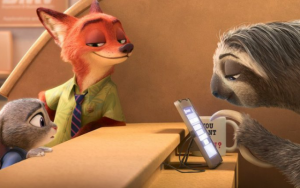Disney animator Trent Correy may be an Ottawa native, but three years of living and working in Burbank, Calif., have changed him.
“I get home about once or twice a year now,” he says. “It’s hard to go in the winter, my body has adapted to here. I tend to send my parents photos of me on the beach in February when it is -42 C back home. I have flip flops on now while we’re talking just to turn the knife a little bit.”
Ironically the sun worshipper’s breakout was helping to animate the snowman Olaf in Frozen. You’ve also seen his handiwork in Big Hero 6 and this weekend he’s back with the furry and funny film Zootopia.
“The nice part of Zootopia was working with a number of different characters,” says the Algonquin College graduate. “I worked with everything from a mouse to a sloth to an elephant. It kept the job very interesting.”
Set in an alternate universe where animals, both predator and prey, live harmoniously in a city called Zootopia, the movie’s funniest sequence involves a slow moving sloth named Flash. It was the first scene Correy helped animate. “There are a lot of challenges animating a sloth moving at that speed,” he says, “and a lot of other challenges animating a mouse or an elephant with their different weights and animal attributes.”
The 28-year-old is a rising star at Disney — he’s currently working on the mythological epic Moana — so it might come as a surprise that he didn’t take art in high school.
“I failed art,” he admits. “It was totally my fault. I wasn’t into the art history stuff at the time and I was really interested in drawing cartoons. That was looked upon as not real art so the teacher and myself had disagreements. I ended up having to take drama, and that’s fun too.
“I did always love to draw. I have to thank my mom, who is an artist, who encouraged me to draw and keep going.”
He rediscovered his passion for art after high school and now joins the rather long and impressive list of Canadians who are helping to shape the future of animation. I ask him why Canadians are so in demand as animators.
“There is a rich history of animation in Canada with the NFB and a lot of TV work in the ’80s and ’90s,” he says. “I think a lot of it has to do with work ethic. I tend to see a lot of people who come from TV animation who are faster. They have to be because they get paid per frame in a lot of places in Canada, whereas here it’s salary. So to make your money you have to be fast, you have to be efficient and you have to be economical in your choices.
“Our whole crew here is very international, we have people from all over the world. I think there is a bit of, ‘I’m coming from a different country and I’m trying to prove myself in this big place.’ It feels so far away from Ottawa.”

